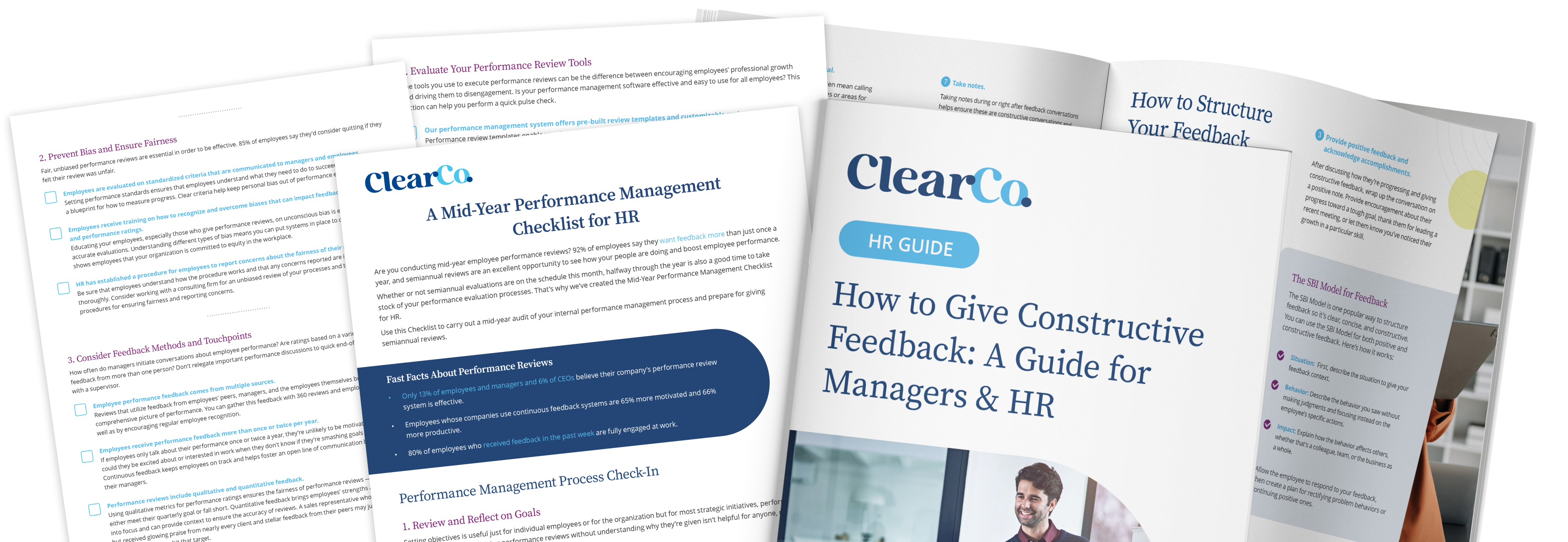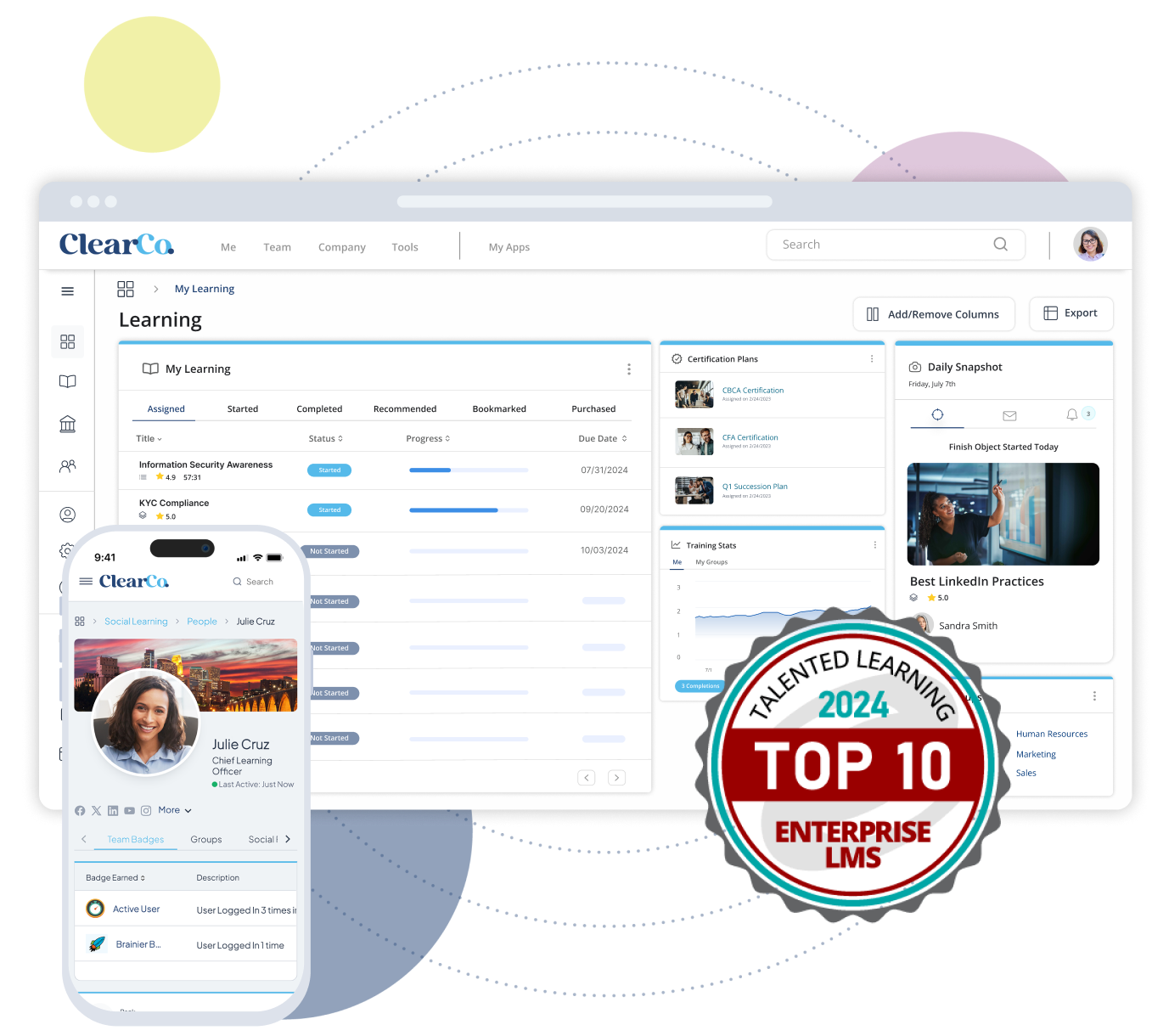This post about employee performance tools was originally published in October 2022 and updated with new information in April 2025.
Does your company’s approach to performance management really help employees reach their potential? Does it lead to long-term, lasting improvements, brief productivity spikes, or worse, declines in performance? Most importantly, are you measuring and monitoring productivity consistently so you can answer questions like these? If you need more reliable, effective performance management strategies, you’re not alone.
Surprisingly, you’re in the vast majority of human resources leaders — 82% said their current performance management is not effective. You need employee performance tools that actually help your people reach their full productivity potential and sustain it. With a modern performance management solution, you can effortlessly monitor and measure productivity. You’ll also be able to uncover opportunities to improve productivity that, without technology, can easily go unnoticed.
There are lots of employee performance management tools on the market, so how do you decide which features you need most? Learn more about a few of the most impactful software tools your team can use to monitor, measure, and improve productivity.
Why Use Employee Performance Tools?
The way we manage employee performance leaves a lot to be desired. On top of the fact that most HR leaders feel current strategies are not working, just 41% of employees are performing optimally. That means they’re doing their best work and expect to be able to continue that for the next year.
In short, most employees could be more productive, but their companies’ performance management is not enabling them. That’s an issue because employee performance has a significant impact on the business. If you’re not tracking, measuring, and looking for ways to improve productivity, your employees — and your business — can’t reach their full potential.
Luckily, there are tons of proven ways to encourage productivity. Employees today want:
- Clear expectations with touchpoints to monitor progress
- The tools and resources they need to do their jobs
- Appreciation from their managers
- A sense of purpose and connection
Though it may be surprising, the key to meeting their needs is a robust performance management system. Watch performance improve and productivity rise when you build a performance management framework utilizing these essential employee performance tools.
1. Performance Reviews
The list of the benefits of employee performance appraisals is long, but the biggest advantages come when performance check-ins happen more often. Annual performance reviews are better than none at all, but 92% of employees want to hear feedback more than once a year.
The best performance review software gives you the ability to conduct a variety of different types of evaluations throughout the year:
- Annual, Semi-Annual, and Quarterly Reviews
- 30-, 60-, or 90-Day New Hire Reviews
- Competency and Roles-Based Reviews
- Time-Based Reviews
- Peer and 360-Degree Reviews
Performance evaluations give managers and employees a chance not just to talk about what they’ve accomplished through the year, but also a chance to look ahead and set goals for the future. You might choose to run reviews at the same time each year for all employees, or give anniversary reviews on each person’s work anniversary.
2. Regular One-on-Ones
While performance reviews are certainly necessary, they’re still a more formal way of managing performance and only happen a few times a year, at most. If your goal is continuous improvement, managers need to give continuous feedback. Performance management statistics show that 43% of highly engaged employees get feedback from managers at least once weekly.
Managers should have one-on-ones with their team members at least once weekly for the most engagement and productivity benefits. Weekly check-ins give employees more chances to ask questions and make sure they’re progressing as expected, and managers more opportunities to correct mistakes and offer guidance. Open lines of communication also contribute to a more trusting, transparent company culture.
Another way to check in with employees regularly is with engagement pulse surveys — one-question surveys that “take the pulse” of employee engagement. The most common pulse survey is the Employee Net Promoter Score (eNPS) survey, which asks respondents to rate the likelihood that they’d recommend their workplace to friends and family. That way, you can get a quick idea of engagement overall and how it differs across the organization.
3. 360-Degree Reviews
What is 360-degree feedback? It’s a method of reviewing employee performance in which a number of their peers complete evaluations. 360-degree reviews are a way of creating a complete picture of employee performance instead of relying on direct managers’ input only. Employees tend to find 360-degree feedback to be more accurate, fair, and validating than traditional reviews.
360-degree reviews usually include:
- A self-assessment completed by the employee that’s being evaluated
- Peer reviews from a number of the employee’s colleagues (usually four to eight coworkers)
- A traditional performance review that’s completed by the employee’s manager
That may seem like a lot of information to gather for one reviewee, but that’s one of the biggest benefits of 360 review software. With software, your HR team can easily create 360 reviews, launch review cycles, and keep excellent records.
4. Goal Planning and Alignment
Only 46% of employees surveyed by Gallup said they know what they’re expected to accomplish at work. That’s negatively affecting employee engagement, which in turn hurts productivity. After all, how can employees be productive when productivity isn’t defined?
That’s why goal-setting is an employee performance tool you can implement immediately for a boost in productivity. When managers and employees work together to set individual goals that are aligned with organizational goals, employees understand what they need to do and how their work contributes to the success of the business. Goals and objectives not only enable managers to monitor their teams’ progress but also help employees feel more connected to their work and the company as a whole.
5. AI Performance Management Tools
AI in performance management is changing the way we work, and it’s easy to see why. AI tools help track employee performance in real time, alerting managers when someone isn’t hitting their goals so they can step in and offer support. Instead of waiting for the next annual or semi-annual review, AI makes it possible to provide feedback and guidance when it matters most. It can even help set more meaningful goals by analyzing past performance data and business goals, ensuring expectations are both realistic and impactful.
One of AI’s coolest features is predictive analytics. By digging into performance data, AI can spot patterns that might lead to employee disengagement or turnover. With that insight, companies can take action before problems arise, whether that’s providing more recognition, offering training opportunities, or mapping out personalized development plans. AI doesn’t replace human managers or their feedback, but it does make their jobs easier and help them focus on what really matters — supporting their team and driving results.
Gearing Up for Mid-Year Performance Reviews?
We’ve got the resources you need for productive performance conversations.
6. Employee Recognition Programs
We can’t deny that bonuses and raises are excellent ways to give rewards and recognition to your employees, but they’re not the only ways. Employee recognition increases engagement and productivity — it’s just a fact. 37% of employees say recognition is their top motivator to produce great work. 69% say more recognition would motivate them to work harder.
The great thing about employee recognition is that it’s easy to do. Encourage your managers to call out employees’ accomplishments during weekly check-ins, team meetings, and in company Slack channels. Make a big deal when employees have birthdays and reach work anniversaries, sharing congratulations via email or during all-staff meetings.
You can also use software to make this process even easier. Performance management software can automatically notify the whole company of big milestones, allowing other employees to congratulate their coworkers. Software also gives employees a platform to publicly praise colleagues — and then keeps a record of those comments, so they’re reflected in future performance reviews.
7. Personal Development Plans (PDPs) and Performance Improvement Plans (PIPs)
Inside or outside of the workplace, personal development plans stem from a desire for growth. At work, employee development plans can help your people meet their career goals, like growing their leadership skills or earning a new certification.
The increased focus on development isn’t just about ambition — it’s a necessity. By 2030, 39% of skills will be outdated, according to the World Economic Forum. It’s no surprise that employees crave opportunities to upskill and grow.
PDPs are focused on honing employees’ soft skills, like critical thinking and problem-solving. These plans help your workforce stay agile and motivate your employees, reminding them they can still learn and grow and preventing the kind of stagnation that makes top talent look elsewhere.
Performance improvement plans, on the other hand, are created when employees are struggling to complete their daily work or achieve goals. PIPs give employees a chance to bring their performance up to its expected level and can help uncover what’s causing the dip in productivity. Then, managers can offer more training or additional coaching and motivate employees to achieve their goals or determine if they’re not a good fit for the role.

8. Performance Analytics and Reporting
If you’re using performance management software, generating reports and analyzing their results is far easier than if you’re still managing the process on paper. Today’s performance management software can tell you more than you ever thought possible — all without adding tasks to HR teams’ overflowing plates. Here’s what you can learn from performance analytics:
- What are some of the traits your highest-performing employees have in common?
- Are managers scoring their team members fairly and accurately?
- Do any employees need more training or resources to do their jobs?
- How do employee engagement levels and performance scores relate to each other?
With the ability to access such deep insights, you can make choices based on real employee data and then watch their impact on performance. For example, if you notice one manager gives male employees consistently higher performance scores, it’s an opportunity for bias training and a record of their conduct in the event that it doesn’t improve.
As we mentioned, predictive analytics allow you to forecast the future so you can prevent potential issues or provide more support for stellar productivity. Analytics also give you the chance to find out what sets high performers apart so you can look for those traits in future applicants and build the most productive workforce possible.
The All-In-One Performance Management Solution
With software, performance reviews become less about the logistics and more about giving effective feedback that actually helps employees improve. HR and managers can automate the tedious parts of performance management, like reminding employees to complete unfinished peer reviews. Performance software also gathers people data into insightful reports that help you understand what drives — and slows — productivity.
Would you believe us if we said it’s possible to get all of these tools — and more — from one modern performance management system? With ClearCompany, it’s possible.
There are many different types of performance management systems, but there’s only one like ClearCompany. Equipped with all the tools you need to monitor, measure, and improve productivity, ClearCompany is also a full lifecycle talent management platform. Recruit, onboard, engage, evaluate, develop, and retain your top talent with our integrated Talent Management System.
But first, discover what the best Performance Management software on the market can do for your organization. Sign up for a demo of the ClearCompany Performance Management Platform to see how you can start increasing productivity.



